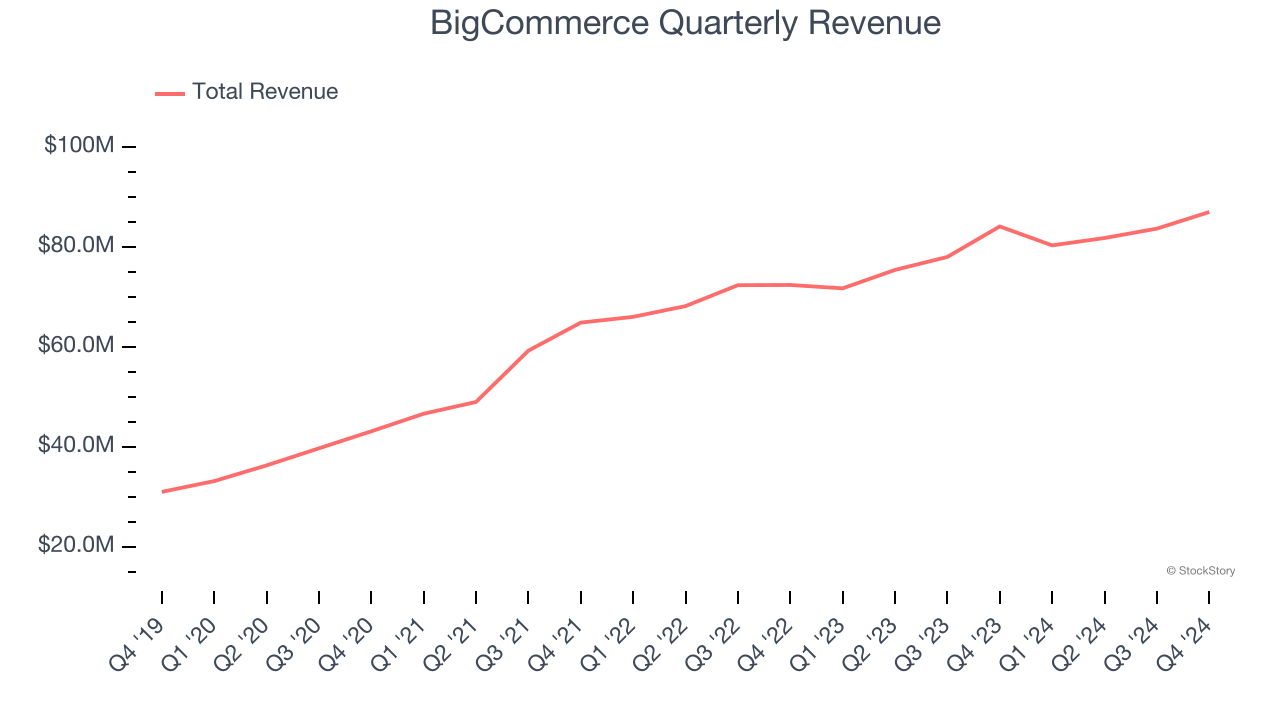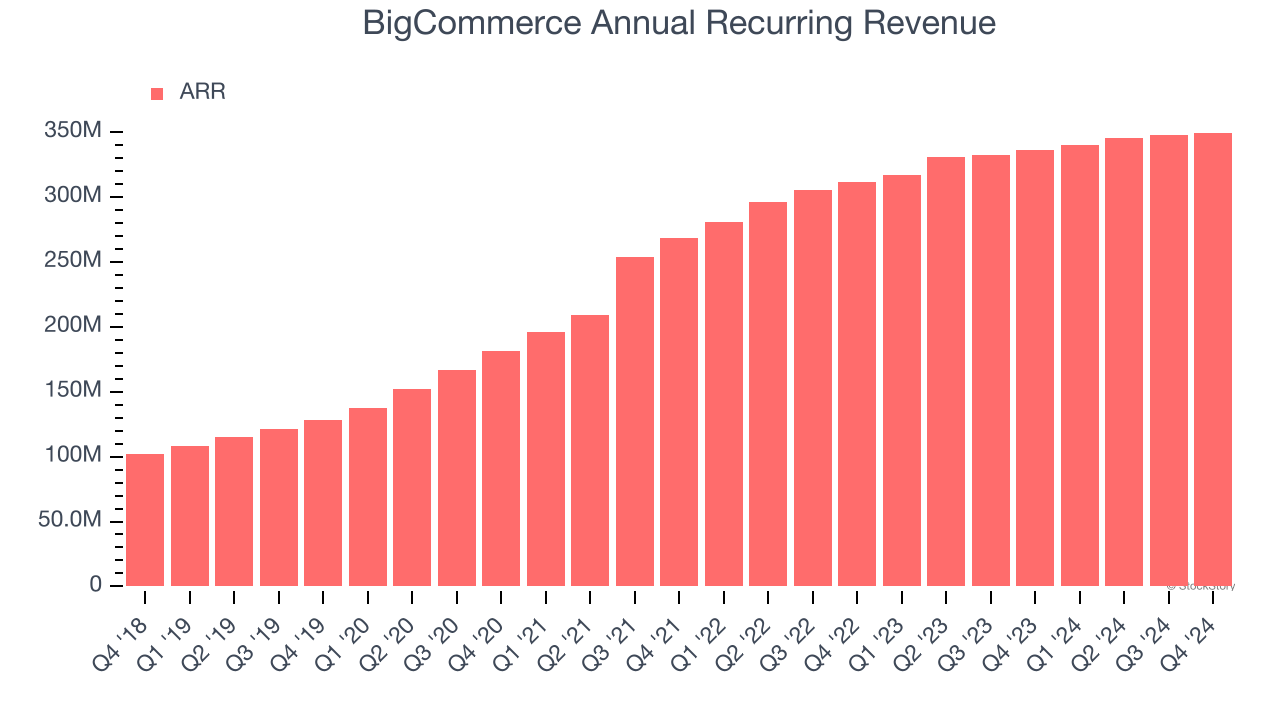
E-commerce software platform provider BigCommerce (NASDAQ: BIGC) met Wall Street’s revenue expectations in Q4 CY2024, with sales up 3.4% year on year to $87.03 million. On the other hand, next quarter’s revenue guidance of $82.2 million was less impressive, coming in 1.8% below analysts’ estimates. Its non-GAAP profit of $0.11 per share was 65.7% above analysts’ consensus estimates.
Is now the time to buy BigCommerce? Find out by accessing our full research report, it’s free.
BigCommerce (BIGC) Q4 CY2024 Highlights:
- Revenue: $87.03 million vs analyst estimates of $86.86 million (3.4% year-on-year growth, in line)
- Adjusted EPS: $0.11 vs analyst estimates of $0.07 (65.7% beat)
- Adjusted Operating Income: $10.09 million vs analyst estimates of $5.51 million (11.6% margin, 83.1% beat)
- Management’s revenue guidance for the upcoming financial year 2025 is $346.1 million at the midpoint, missing analyst estimates by 1.1% and implying 4% growth (vs 7.8% in FY2024)
- Operating Margin: -0.9%, up from -6.8% in the same quarter last year
- Free Cash Flow Margin: 13.3%, up from 5.4% in the previous quarter
- Annual Recurring Revenue: $349.6 million at quarter end, up 3.9% year on year
- Market Capitalization: $524.4 million
“Over the last several months, we have focused on executing our go-to-market transformation, aligning our strategy, structure and messaging to reflect the full power of BigCommerce,” said Travis Hess, CEO of BigCommerce.
Company Overview
Founded in Sydney, Australia in 2009 by Mitchell Harper and Eddie Machaalani, BigCommerce (NASDAQ: BIGC) provides software for businesses to easily create online stores.
E-commerce Software
While e-commerce has been around for over two decades and enjoyed meaningful growth, its overall penetration of retail still remains low. Only around $1 in every $5 spent on retail purchases comes from digital orders, leaving over 80% of the retail market still ripe for online disruption. It is these large swathes of the retail where e-commerce has not yet taken hold that drives the demand for various e-commerce software solutions.
Sales Growth
Reviewing a company’s long-term sales performance reveals insights into its quality. Any business can have short-term success, but a top-tier one grows for years. Over the last three years, BigCommerce grew its sales at a 14.8% annual rate. Although this growth is acceptable on an absolute basis, it fell short of our benchmark for the software sector, which enjoys a number of secular tailwinds.

This quarter, BigCommerce grew its revenue by 3.4% year on year, and its $87.03 million of revenue was in line with Wall Street’s estimates. Company management is currently guiding for a 2.3% year-on-year increase in sales next quarter.
Looking further ahead, sell-side analysts expect revenue to grow 5.1% over the next 12 months, a deceleration versus the last three years. This projection doesn't excite us and indicates its products and services will see some demand headwinds.
Today’s young investors won’t have read the timeless lessons in Gorilla Game: Picking Winners In High Technology because it was written more than 20 years ago when Microsoft and Apple were first establishing their supremacy. But if we apply the same principles, then enterprise software stocks leveraging their own generative AI capabilities may well be the Gorillas of the future. So, in that spirit, we are excited to present our Special Free Report on a profitable, fast-growing enterprise software stock that is already riding the automation wave and looking to catch the generative AI next.
Annual Recurring Revenue
While reported revenue for a software company can include low-margin items like implementation fees, annual recurring revenue (ARR) is a sum of the next 12 months of contracted revenue purely from software subscriptions, or the high-margin, predictable revenue streams that make SaaS businesses so valuable.
BigCommerce’s ARR came in at $349.6 million in Q4, and over the last four quarters, its growth was underwhelming as it averaged 5.1% year-on-year increases. This alternate topline metric grew slower than total sales, which likely means that the recurring portions of the business are growing slower than less predictable, choppier ones such as implementation fees. If this continues, the quality of its revenue base could decline. 
Customer Acquisition Efficiency
The customer acquisition cost (CAC) payback period measures the months a company needs to recoup the money spent on acquiring a new customer. This metric helps assess how quickly a business can break even on its sales and marketing investments.
BigCommerce is efficient at acquiring new customers, and its CAC payback period checked in at 40.7 months this quarter. The company’s relatively fast recovery of its customer acquisition costs means it can attempt to spur growth by increasing its sales and marketing investments.
Key Takeaways from BigCommerce’s Q4 Results
We were impressed by how significantly BigCommerce blew past analysts’ EPS and EBITDA expectations this quarter. On the other hand, its revenue guidance for next year missed and suggests a significant slowdown in demand. Overall, this quarter could have been better, but the stock traded up 1.5% to $6.80 immediately after reporting.
So do we think BigCommerce is an attractive buy at the current price? When making that decision, it’s important to consider its valuation, business qualities, as well as what has happened in the latest quarter. We cover that in our actionable full research report which you can read here, it’s free.
